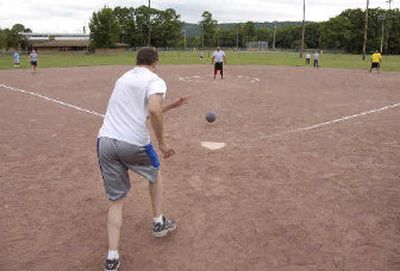Kickball comeback

SYRACUSE, N.Y. – Don Radell stood on the pitcher’s mound, his socks hoisted to just below his knees. One black, one red, a tiny bit of skin showing between the tops of the socks and his baggy shorts. His Little League son said it brings good luck, so why not?
“It seems ridiculous, I know, but you almost can’t help having fun,” he said.
For Radell and many others, it’s recess revisited – but these players left fifth grade a long time ago. It’s kickball, and the schoolyard game is catching on with adults such as the 33-year-old Radell, who plays on a team with his wife, her friends and his bowling and softball buddies.
Mirroring a nationwide rise in interest, Onondaga County formed a kickball league last summer with eight teams. The league proved so popular that the county formed a fall league, added a second night and expanded to 13 teams. This summer, the league swelled to 24 teams – and county parks officials had to turn away another dozen teams because there weren’t enough fields.
“It was a struggle at first getting people interested. The typical reaction was, ‘Kickball? You’re kidding me. That’s not a real sport!”’ said Gary Lopez, who runs the county leagues and plays on a team.
“Now it’s the buzz. People started talking, telling their friends. It’s an activity off the beaten path. It’s fun. It’s social. And you get some exercise.”
The county expects to add a third night this fall.
The city of Syracuse noticed the success and began a league this summer with eight teams.
“It’s a kid’s game. Who doesn’t enjoy being a kid?” coordinator Jerry Brown said. “It’s even fun to just watch.”
With dodgeball and wiffleball making comebacks, it was only natural a kickball revival should follow.
The World Adult Kickball Association was formed in 1998 when three former University of Virginia classmates and a fourth friend launched a league mixing socializing and athletics – with emphasis on the socializing. The league began with eight teams and about 150 players, who played on the National Mall in Washington, D.C.
WAKA has grown to more than 700 teams in 18 states, with more than 17,000 registered players, said Tiffany Ficklin, the group’s national spokeswoman, one of 30 paid employees who run what is a nearly million-dollar-a-year business.
Along with the Washington, D.C.-Virginia area, California also has become a hotbed for kickball. There are five WAKA divisions in New York – three in New York City, one on Long Island and the other in Buffalo.
WAKA sponsors regional playoffs that lead to two national tournaments – one in the spring and summer, the other for fall ball.
Ficklin, 30 and a mother of two, began working full time for WAKA after organizing a league in her home state of New Mexico. Her husband also plays.
“It’s our weekly guaranteed date night. We play a game and then we go out for drinks with teammates and friends,” she said.
For many adult players, it can be a family outing as well.
“There’s been a serious decline in playground games,” Ficklin said. “Many schools don’t have recess any more. Others have cut back on PE classes. Many of today’s kids don’t even know about kickball. This is helping keep it alive. The kids go to games. They see mom and dad playing and they want to play, too.”
The rules are simple – remember, it’s a child’s game. You kick the ball. You run around four bases. You get three outs. The 10-inch-diameter rubber ball shouldn’t be overly inflated – the less air, the more wobbly and spasmodically it flies, and the more difficult it is to catch.
Everyone agrees, though: No “bouncies.” Pitchers must roll the ball. The last bounce crossing home plate can’t be higher than 12 inches off the ground.
Peter Waack likes the memories stirred up by playing kickball.
“I remember getting to school an hour early to play kickball in the schoolyard,” said Waack, business manager of the Daily Orange student newspaper at Syracuse University.
For the past three years, Waack has helped direct a one-day kickball festival for the Syracuse Professional and Recreation Club, a social cadre of the city’s young professionals.
No organized teams. Players sign up individually. They line up schoolyard style and count off 1-9 over and over until teams are drawn. From three dozen players the first year, the event has tripled to more than 100, some from as far away as Albany and Buffalo. Waack expects a turnout topping 150 next year.
“You know, even if you have bad memories of kickball as a kid, if you were the last one picked or you made out with a chance to win the game, you can go out there and make them right, or at least have a good laugh trying,” Waack said.